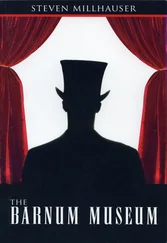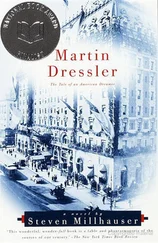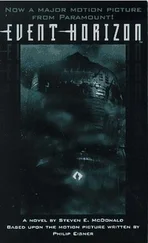One evening at an alehouse, Crane suddenly began to speak of his admiration for Thomas Edison. Unfolding a newspaper, he pointed to an interview in which the inventor insisted on the importance of “chance” in his discoveries. Crane read several passages aloud, then folded the paper and looked up at Curtis. “A methodical man who believes in chance. Now what does that sound like to you, Curtis?” Curtis thought for a moment before replying: “A gambler.” Crane, looking startled and then pleased, gave a laugh and a shake of the head. “I hadn’t thought of that. Yes, a gambler.” “And you were thinking—” “Oh, nothing, nothing — do you have any matches, Curtis, I never seem to — but a methodical man, who believes in chance — tell me, Curtis, have you ever heard a better definition of an artist?”
Not until March of 1884 was a new piece announced. The opening took place at eight o’clock in the evening. The black velvet curtain rose to reveal Picnic on the Hudson, a monumental painting that showed groups of picnickers sitting in sun-checked green shade between high trees. Sunlight glowed in sudden bursts: on the corner of a white cloth spread on the grass, on a bunch of red grapes in a silver dish, on the lace sleeve of a lavender dress, on the blue-green river in the background, where sunlit portions of a two-stacked steamer were visible through the trees. As the pianist played a medley of American melodies (“Aura Lee,” “Sweet Genevieve,” “Carry Me Back to Old Virginny,” “I’ll Take You Home Again, Kathleen”), Picnic on the Hudson began to show signs of life: the second of the steamer’s smokestacks emerged fully from behind the trunk of an oak, a squirrel moved along a branch, the hand of a picnicker held out a glistening crystal glass, into which, from the mouth of a wine bottle, poured a ruby-colored liquid. A small boy in boots and breeches and a feathered hat strolled into view, holding in one hand a red rubber ball. A young woman, wearing a straw poke bonnet trimmed with purple and gold pansies, slowly smiled. The several groups of men and women seated on the grass seemed to feel a great sense of peacefulness, in the warm shade, under the trees, on a summer afternoon beside the Hudson. A number of viewers later said that the painting created in them a feeling of deep repose.
As the picnickers relaxed on the riverbank, one of them, a mustached young man in a bowler hat who had been gazing toward the river, turned his head lazily in the direction of the audience and abruptly stopped. The woman in the straw bonnet, following his gaze, turned and stared. And now all the faces of the people in the painting turned to look toward the viewers, many of whom later spoke of feeling, at that moment, a sensation of desire or yearning. Someone in the audience rose and slowly climbed the steps to the stage; others soon followed. Once on the stage, they walked up and down along the painting, admiring its Verisimilist accuracy of detail — the brown silk stitching on the back of a woman’s white kid glove, the webbed feet and overlapping feather tips of a tiny seagull sitting on the railing of the steamer, the minuscule fibers visible in the torn corner of a folded newspaper on the grass. Contemporary reports are unclear about what happened next, but it appears that a man, reaching out to feel the canvas, experienced in his fingertips a sensation of melting or dissolving, before he stepped into the painting. Those who entered the painting later reported a “dreamlike feeling” or “a sense of great happiness,” but were less clear about the physical act of entry. Most spoke of some kind of barrier that immediately gave way; several felt hard canvas and paint. One woman, a Mrs. Amelia Hartman, said that it reminded her of immersing herself in the ocean, but an ocean whose water was dry. Inside the painting, the figures watched them but did not speak. The mingling seems to have lasted from about ten minutes to half an hour, before the visitors experienced what one described as a “darkening” and another as “stepping into deep shade.” The deep shade soon revealed itself to be a corridor lit by dimmed gas jets, which led to a door that opened into the side of the auditorium.
When all the members of the audience had returned to their seats, the pianist drove his music to a crescendo, threw back his head with a great agitation of hair, struck three ringing chords, and stopped. The figures in the painting resumed their original poses. Slowly the curtain came down. Harlan Crane walked briskly out onto the apron, bowed once, and strode off. The showing was over.
Newspaper reviews outdid themselves in their attempts to explain the new range of effects produced by Crane in Picnic on the Hudson. The New York News proposed a hollow space behind the painting, with actors and a stage set; the picture, an ingenious deception, was nothing but a diaphanous screen that separated the actors from the stage. The proposed solution fails to mention the hardness of the canvas, as reported by many members of the audience, and in any case it cannot explain why no one ever detected anything resembling a “diaphanous screen,” or how the mysterious screen vanished to permit entry. Other explanations are equally unsatisfactory: one columnist described the barrier as an artificially produced “mist” or “vapor” onto which magic-lantern slides were projected, and another suggested that the audience, once it reached the stage, had inhaled an opiate sprayed into the atmosphere and had experienced a shared hallucination.
These explanations, far from revealing the secret of Crane’s art, obscured it behind translucent, fluttering veils of language, which themselves were seductive and served only to sharpen the public’s curiosity and desire.
Picnic on the Hudson was shown to a packed house every evening at eight o’clock, while The Ballroom continued to be displayed daily to diminishing audiences. By early summer, when evening attendance at the Phantoptic Theater showed signs of falling off, a rumor began to circulate that Crane had already started a new work, which would usher in an age of wonder; and it was said that if you listened closely, in the theater, you could hear the artist-showman moving about in the basement, pushing things out of the way, hammering, preparing.
A single anecdote survives from this period. In a dockside restaurant with a view of the Brooklyn ferry across the river, Crane told W. C. Curtis that as a child he had thought he would grow up to be a ferryboat captain. “I like rivers,” he said. “I thought I’d travel a lot.” Curtis, a well-traveled man who had spent three years in Europe in his twenties, urged Crane to go abroad with him, to Paris and Munich and Venice. Crane appeared to consider it. “Not far enough,” he then said. Curtis had also spent six months in China; he immediately began to sing the praises of the Orient. Crane gave “an odd little laugh” and, with a shrug of one shoulder, remarked, “Still not far enough.” Then he lit up his pipe and ordered another dish of Blue Point oysters.
We know very little about Terra Incognita , which was shown only a single time (February 6, 1885). From the foyer of the Phantoptic Theater, visitors were led down a flight of steps into a dark room illuminated by a few low-burning gas jets in glass lanterns suspended from the ceiling. Gradually the viewers became aware of a painting rising up on all sides — a continuous twelve-foot-high canvas that stretched flat along all four walls and curved at the wall junctures.
The vast, enclosing composition seemed at first to be painted entirely black, but slowly other colors became visible, deep browns and blackish reds, while vague shapes began to emerge. Here the evidence becomes confused. Some claimed that the painting represented a dark cavern with rocks and ledges. Others spoke of a dark sea. All witnesses agreed that they gradually became aware of shadowy figures, who seemed to float up from the depths of the painting and to move closer to the surface. A woman screamed — it isn’t clear when — and was harshly hushed. At some point several figures appeared to pass from the surface into the dark and crowded room. Precisely what took place from then on remains uncertain. One woman later spoke of a sensation of cold on the back of her neck; another described a soft pressure on her upper arm. Others, men and women, reported “a sensation of being rubbed up against, as by a cat,” or of being touched on the face or bosom or leg. Not all impressions were gentle. Here and there, hats were knocked off, shawls pulled away, hands and elbows seized. One witness said: “I felt as though a great wind had blown through me, and I was possessed by a feeling of sweetness and despair.” Someone screamed again. After a third scream, things happened very quickly: a woman burst into tears, people began pushing their way to the stairs, there were cries and shouts and violent shoving. A bearded man fell against the canvas. A young woman in a blue felt hat trimmed with dark red roses sank slowly to the floor.
Читать дальше












